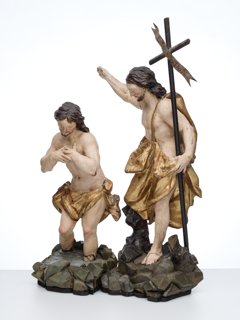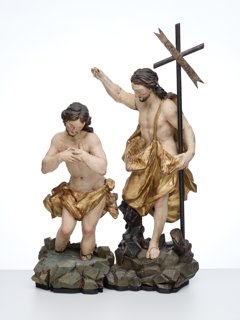Location
Austria, Styria, Graz
Alte Galerie, Universalmuseum Joanneum
Original location:
Austria, Styria, Graz
Parish Church of the Holy Blood (Stadtpfarrkirche zum Heiligen Blut)
Innere Stadt
Artwork
The Sculptural Group Baptism of Christ, Universalmuseum Joanneum, Alte Galerie, Inv. Nr. P 213
Type
Sculptural group
Dimensions
Height: 58 cm, width: 39 cm, depth: 23 cm
Critical History
The group of the Baptism of Christ was situated on top of the font in the Parish Church of the Holy Blood. Since 1915 it has been in the Landesmuseum Joanneum (now: Universalmuseum Joanneum).
Wilhelm Suida1 published it and thought it was by an Austrian sculptor, 18th century. Kurt Woisetschläger2 attributed it to Philipp Jakob Straub and his staff from about 1730–1740. Christine Rabensteiner shared the same opinion. The bodies of St John and Jesus are rounder and softer than such from the master himself.
The base is composed as the water of Jordan, where Jesus stands and the rocky shore for St John. The lost baptismal bowl in John’s hand could have been a shell.
Construction / Execution
St John the Baptist: remnants of metal pieces (for attachments); some fingers are missing, the baptismal bowl is missing; both arms are broken twice, one leg is broken; the present nimbus is not the original one
Christ: both legs are broken.
Base: the base was put together out of several wooden pieces. A new pedestal plate was mounted at the bottom of the base.
In general: woodworm infestation inactive
Components
- Sculpture
- Author: (workshop) Philipp Jakob Straub
- Completed: 1730 – 1740
- Technique(s): wood carving
- Material(s): limewood
- Polychromy
- Completed: 1730 – 1740
Conservation-restoration
- 2018
Treatment Description
The broken parts gave the impulse for previous restorations. During these restorations the broken parts were not only glued together, the complete skincolours were newly made new over the original layers. The gilded parts were newly executed, too. Water gilded areas and polished golden parts of the garments were completely newly gilded over a new chalk layer with red bolus. The present skincolours were treated presumably with ammonia or paint stripper. Therefore they have a milky appearance.
Images
- The sculptural group Baptism of Christ, Universalmuseum Joanneum, Alte Galerie (Universalmuseum Joanneum, Graz, photo by Nicolas Lackner, 2018)
- The sculptural group Baptism of Christ, Universalmuseum Joanneum, Alte Galerie (Universalmuseum Joanneum, Graz, photo by Nicolas Lackner, 2018)
Catalogue entry prepared by Paul-Bernhard Eipper and Christine Rabensteiner
Recommended citation: Paul-Bernhard Eipper and Christine Rabensteiner, The Sculptural Group Baptism of Christ, Universalmuseum Joanneum, Alte Galerie, Inv. Nr. P 213, in: TrArS – Tracing the Art of the Straub Family, 2018, (accessed 19/10/2025) URL


